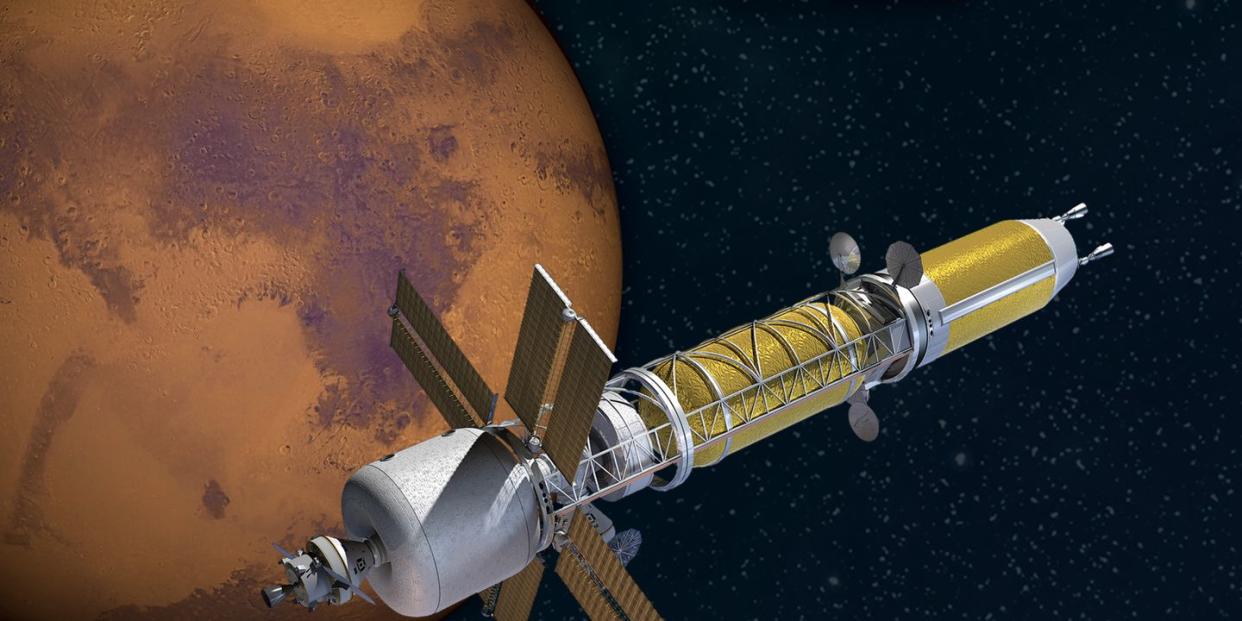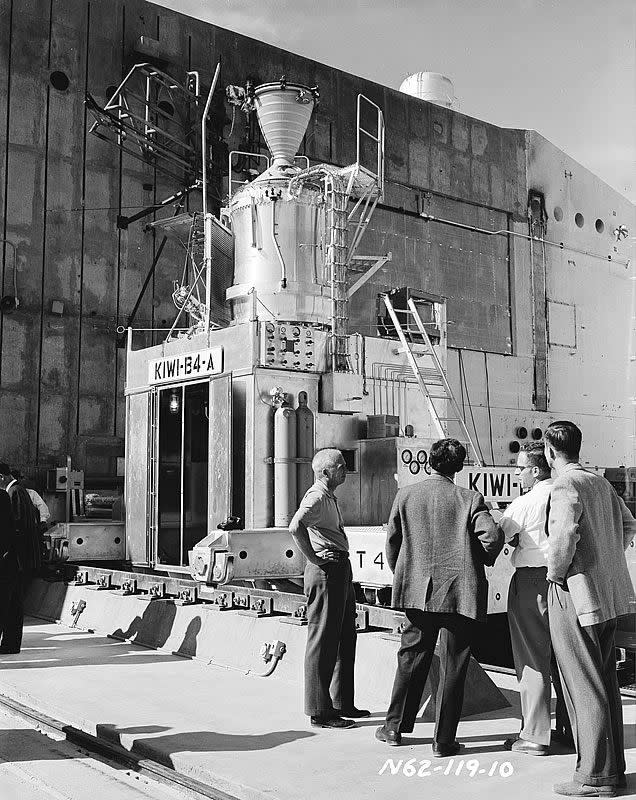NASA Wants Nuclear Engines to Fly Humans to Mars

NASA studied "nuclear thermal propulsion systems" during the Cold War, but shelved the idea because it wasn't necessary.
Nuclear-powered spacecraft could send humans to Mars faster and allow them to abort a dangerous mission and return to Earth.
NASA has already hired a company to start working on a new NTP engine design.
To accomplish what will be the greatest human spaceflight triumph since Apollo 11 - sending astronauts to Mars - NASA is looking to a blast from its nuclear past.
Today's chemical propellant rocket engines may not be the fastest or most efficient way to send a crew to another planet. One idea for the next-generation rocket engine you'd need is to bring back nuclear thermal propulsion (NTP) systems. The technology was studied in the 1950s and 60s, but shelved in the early 70s because of technological challenges, and because there was no clear need for the propulsion system.
Jeff Sheehy, chief engineer of NASA's Space Technology Mission Directorate, says times have changed. Advances in manufacturing, materials science, and engineering have made it possible to design a better fuel element and nuclear reactor than was possible during the Cold War. What's more, and what has really been lacking until now, is a reinvigorated "desire to send crews into deep space," says Sheehy. "I mean the desire has always been there, but the push or the emphasis that NASA has had for the last few years about developing that capability - that has renewed the interest in NTP as an option."
Faster to Mars
A nuclear thermal propulsion rocket engine would use a small nuclear reactor to generate heat from uranium fuel. That thermal energy would then be transferred to a liquid propellant, probably liquid hydrogen, which expands into a gas and is shot out through a nozzle to produce thrust. "So you get the exhaust moving very fast out the back end," Sheehy says.
To begin work on a new NTP rocket engine, NASA awarded an $18.8 million contract to BWXT Nuclear Energy in August 2017. BWXT, which has a long history of making nuclear fuel for the U.S. Navy, will use the money for a three-year project with four primary parts: to design a nuclear reactor that uses low-enriched uranium nuclear fuel in the form of "Cermet" (ceramic metallic) rods; to design an engine that could be mated to the reactor to produce thrust; to study cryogenic storage options for carrying liquid hydrogen propellant; and to develop an exhaust capture system that would be used for future ground testing of the NTP engine.

"What this project is mainly looking at is a fuel element design that can allow us to use low-enriched uranium," Sheehy says. "Instead of the highly enriched uranium that has been the basis for previous NTP efforts, we're looking at using a mixture where the amount of fissionable material is under 20 percent. ... The handling, the safety, the approval process, licensing, all that, is expected to be somewhat less strenuous than highly enriched, weapons-grade uranium. This is the kind of system that a university might have as a reactor."
Nuclear thermal propulsion has a number of advantages over current chemical and electric propulsion systems. A spacecraft using NTP could cut the travel time to Mars by 20 or 25 percent compared to chemical rocket engines, Sheehy says. Alternatively, the higher energy output means a spacecraft with NTP could launch to Mars during a broader launch window than spacecraft with conventional rocket engines. The latter are limited to a 30-day window every 26 months that's dependent on the orbital positions of Earth and Mars.
Perhaps most importantly, NTP engines would allow astronauts on a mission to Mars to more readily abort and fly back to Earth. Chemical propellants provide a high amount of thrust, but burn up quickly. Accordingly, Sheehy says, a crewed mission to Mars using chemical propellants would likely need to send the fuel for the return trip in advance. In other words, astronauts flying to Mars with chemical rocket engines would need to get there to pick up the fuel they need to fly home.
"You might have the opportunity to abort a month or two into the mission [with NTP]," says Sheehy. "Whereas with a chemical system, once you put yourself on a trajectory to Mars, you're basically going to Mars. You maybe wish you could come home."
Nuclear vs. Chemical vs. Electric
A big advantage of NTP engines is that they can run much longer than chemical rocket engines, such as the Space Shuttle main engines or the Merlin engines on SpaceX Falcon 9 rockets, and still produce much more thrust than an electric propulsion system, such as the ion thrusters used on satellites. NTP is a happy medium.
"The Space Shuttle main engines were mounted on that enormous orange tank, full of oxygen and hydrogen, and as enormous as it was, it only had enough fuel to power the three main engines on the Space Shuttle for about 10 minutes," says Sheehy. "And then you've used all of that propellant and the enormous orange tank is gone." The NTP system NASA and BWXT are designing, on the other hand, could fire continuously for an hour or more.

"The other important consideration is how you size your engine," says Sheehy. "What we're looking at for the NTP system is an engine that would be in the range of 15,000 to 25,000 pounds of thrust force, and we might group three of those together."
The efficiency of a rocket engine is measured in specific impulse. "It's sort of similar to miles per gallon on a car," says Sheehy. Engineers measure the amount of thrust force of an engine in pounds of thrust, and then divide that value by the fuel consumption rate in pounds per second, which leaves you with a specific impulse measured in seconds.
"[NTP specific impulse] is actually twice as good as a chemical system, your typical hydrogen-oxygen rocket," says Sheehy. "It's 450 seconds for chemical rockets. The NTP system we're designing would be about 900 seconds. So you get a lot more thrust force for flow rate of propellant."
An electric propulsion engine - such as a Hall thruster that ionizes xenon gas - has a high specific impulse, as much as 10 times that of NTP. But the thrust is very low. That makes the technology good for making minor adjustments to the orbits of satellites. The biggest ion thrusters in space are only about 4 1/2 kilowatts. A much larger, 100-kilowatt ion thruster known as X3 is currently being tested at NASA Glenn as a potential engine for missions to Mars, but even an ion thruster that big has a much lower thrust force than an NTP system.
"A chemical system has tremendous thrust force, but low miles per gallon, and you can only carry enough propellant to thrust for minutes," says Sheehy. "A solar electric system has very low thrust force, but very high miles per gallon, and you can carry enough fuel to thrust for years. NTP kind of marries the high thrust of the chemical system with a higher... miles per gallon or specific impulse."
The efficiency of NTP comes from its propellant of choice: molecular hydrogen. By using the lightest molecule available, the engine can hurl exhaust out the back at incredible speeds of about 9 kilometers per second. "What you want to do in rocketry is throw things out the back very fast, and the way to get things going very fast - or part of the way to do that - is if they're very light," Sheehy says.

Liquid hydrogen can be a tricky propellant, though, because the boiling point is so low. For molecular hydrogen to remain a liquid, its cryogenic tanks need to be cooled to 20 degrees Kelvin, cold than -250 degrees Celsius. Designing the propellant tanks will be one of the challenges for BWXT, although the rest of the engine components for the NTP engine should be relatively straightforward.
"There's been a lot of development over the last 50 or 60 years working with hydrogen as a propellant," says Sheehy. "All the engine components, like pumps and valves and those sorts of things, have been refined over decades, and so there's a heritage there."
Cold War Tech Comeback
The NTP project comes at a time when NASA is also working on small nuclear reactors to power ground systems on Mars, such as habitats and chemical processing plants. These reactors, known as Kilopower, will have "substantially different requirements" from an NTP system.
"The NTP reactor has to run pretty hot because you want to impart as much thermal energy to that propellant as you can," says Sheehy. "And so it runs up near the limits of the materials, whereas the nuclear surface power reactors run at a lot lower temperature."

But building an NTP engine is just part of the equation. You'd also need to estimate just how hard (and costly) it would be to build an interplanetary spacecraft powered by nuclear thermal propulsion. Sheehy figures the cost at a few billions of dollars, though the full cost analysis will not be available for another year or so.
"Whether NASA ultimately decides to build the nuclear thermal propulsion system for in-space transportation is still TBD, but what we are doing now is development that will allow the agency to take that step,'" Sheehy says.
What is clear, however, is that NASA is turning back to nuclear fission technologies of decades past. With improved materials, better understanding of engine systems, computer modeling, and a renewed vigor for space exploration, the nuclear technologies that were abandoned during the Cold War could make a comeback in the 21st century - for the colonization of Mars.
You Might Also Like
